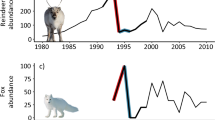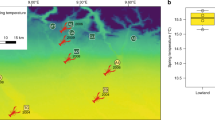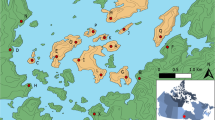Abstract
Field experiments that measure natural selection in response to manipulations of the selective regime are extremely rare1, even in systems where the ecological basis of adaptation has been studied extensively. The adaptive radiation of Caribbean Anolis lizards has been studied for decades2,3,4,5, leading to precise predictions about the influence of alternative agents of selection in the wild. Here we present experimental evidence for the relative importance of two putative agents of selection in shaping the adaptive landscape for a classic island radiation. We manipulated whole-island populations of the brown anole lizard, Anolis sagrei, to measure the relative importance of predation versus competition as agents of natural selection. We excluded or included bird and snake predators across six islands that ranged from low to high population densities of lizards, then measured subsequent differences in behaviour and natural selection in each population. Predators altered the lizards’ perching behaviour and increased mortality, but predation treatments did not alter selection on phenotypic traits. By contrast, experimentally increasing population density dramatically increased the strength of viability selection favouring large body size, long relative limb length and high running stamina. Our results from A. sagrei are consistent with the hypothesis6 that intraspecific competition is more important than predation in shaping the selective landscape for traits central to the adaptive radiation of Anolis ecomorphs.
This is a preview of subscription content, access via your institution
Access options
Subscribe to this journal
Receive 51 print issues and online access
$199.00 per year
only $3.90 per issue
Buy this article
- Purchase on Springer Link
- Instant access to full article PDF
Prices may be subject to local taxes which are calculated during checkout


Similar content being viewed by others
Change history
03 June 2010
The penultimate sentence in the Fig. 2 legend was changed.
References
Reznick, D. N. & Ghalambor, C. K. Selection in nature: experimental manipulations of natural populations. Integr. Comp. Biol. 45, 456–462 (2005)
Schoener, T. W. Inferring the properties of predation and other injury producing agents from injury frequencies. Ecology 60, 1110–1115 (1979)
Williams, E. E. in Lizard Ecology: Studies of a Model Organism (eds Huey, R.B., Pianka, E.R. & Schoener, T.W.) 326–370 (Harvard Univ. Press, 1983)
Langerhans, R. B., Knouft, J. H. & Losos, J. B. Shared and unique features of diversification in Greater Antillean Anolis ecomorphs. Evolution 60, 362–369 (2006)
Losos, J. B. Lizards in an Evolutionary Tree: Ecology and Adaptive Radiation of Anoles (Univ. California Press, 2009)
Andrews, R. M. Evolution of life histories: a comparison of Anolis lizards from matched island and mainland habitats. Breviora 454, 1–51 (1979)
Schluter, D. Experimental evidence that competition promotes divergence in adaptive radiation. Science 266, 798–801 (1994)
Reznick, D. N., Shaw, F. H., Rodd, F. H. & Shaw, R. G. Evaluation of the rate of evolution in natural populations of guppies (Poecilia reticulata). Science 275, 1934–1937 (1997)
Kingsolver, J. G. H. et al. The strength of phenotypic selection in natural populations. Am. Nat. 157, 245–261 (2001)
Pigliucci, M. & Kaplan, J. M. Making Sense of Evolution: The Conceptual Foundation of Evolutionary Biology (Univ. Chicago Press, 2006)
Irschick, D. J., Vitt, L. J., Zani, P. A. & Losos, J. B. A comparison of evolutionary radiations in mainland and Caribbean Anolis lizards. Ecology 78, 2191–2203 (1997)
Losos, J. B., Jackman, T. R., Larson, A., DeQueiroz, K. & Rodriguez-Shettino, L. Contingency and determinism in replicated adaptive radiations of island lizards. Science 279, 2115–2118 (1998)
Irschick, D. J. et al. A comparison of habitat use, morphology, clinging performance and escape behaviour among two divergent green anole lizard (Anolis carolinensis) populations. Biol. J. Linn. Soc. 85, 223–234 (2005)
Stamps, J. A. & Krishnan, V. V. Territory acquisition in lizards: I. First encounters. Anim. Behav. 47, 1375–1385 (1994)
Rand, A. S. Ecology and social organization in the iguanid lizard, Anolis lineatopus . Proc. US Natl Mus. 122, 1–79 (1967)
Butler, M. A., Sawyer, S. A. & Losos, J. B. Sexual dimorphism and adaptive radiation in Anolis lizards. Nature 447, 202–205 (2007)
Losos, J. B., Schoener, T. W. & Spiller, D. A. Predator-induced behaviour shifts and natural selection in field-experimental lizard populations. Nature 432, 505–508 (2004)
Schoener, T. W. Ecological significance of sexual dimorphism in size in lizard Anolis conspersus . Science 155, 474–477 (1967)
Calsbeek, R. & Irschick, D. J. The quick and the dead: correlational selection on morphology, performance, and habitat use in island lizards. Evolution 61, 2493–2503 (2007)
MacArthur, R. H. & Wilson, E. O. The Theory of Island Biogeography (Princeton Univ. Press, 1967)
Calsbeek, R. & Smith, T. B. Experimentally replicated disruptive selection on performance traits in a Caribbean lizard. Evolution 62, 478–484 (2008)
Schoener, T. W. The Anolis lizards of Bimini: resource partitioning in a complex fauna. Ecology 49, 704–726 (1968)
Calsbeek, R. Sex-specific adult dispersal and its selective consequences in the brown anole, Anolis sagrei . J. Anim. Ecol. 78, 617–624 (2009)
Lailvaux, S. P., Herrel, A., VanHooydonck, B., Meyers, J. J. & Irschick, D. J. Performance capacity, fighting tactics and the evolution of life-stage male morphs in the green anole lizard (Anolis carolinensis). Proc. R. Soc. Lond. B 271, 2501–2508 (2004)
Anderson, D. R. Model Based Inference in the Life Sciences: A Primer on Evidence (Springer, 2008)
Losos, J. B., Schoener, T. W., Langerhans, R. B. & Spiller, D. A. Rapid temporal reversal in predator-driven natural selection. Science 314, 1111 (2006)
Cox, R. M. & Calsbeek, R. Sexually antagonistic selection, sexual dimorphism, and the resolution of intralocus sexual conflict. Am. Nat. 173, 176–187 (2009)
Calsbeek, R. & Smith, T. B. Probing the adaptive landscape on experimental islands: density dependent selection on lizard body-size. Evolution 61, 1052–1061 (2007)
Perry, G., Levering, K., Girard, I. & Garland, T. Jr. Locomotor performance and social dominance in male Anolis cristatellus . Anim. Behav. 67, 37–47 (2004)
Cox, R. M. & Calsbeek, R. Severe costs of reproduction persist in Anolis lizards despite the evolution of single-egg clutch. Evolution (in the press)
Acknowledgements
We thank T. B. Smith for suggestions about experimental design, and B. Calsbeek and A. Gasc for help with predator manipulations. M. C. Duryea, S. Kuchta, M. Logan, M. Najarro and D. Urbach helped to clarify the manuscript. This research was conducted under permits from The Bahamas Ministry of Agriculture and approval from the Dartmouth College Institutional Animal Care and Use Committee. An award from the National Science Foundation to R. Calsbeek, and funding from Dartmouth College, provided financial support.
Author information
Authors and Affiliations
Contributions
Both authors contributed equally to study design, fieldwork and data analysis. R.C. prepared the manuscript with assistance from R.M.C.
Corresponding author
Ethics declarations
Competing interests
The authors declare no competing financial interests.
Supplementary information
Supplementary Information
This file contains Supplementary Methods, Supplementary Tables S1-S2 and Supplementary Figures S1-S2 with legends. Supplementary Table 1 was amended on 3 June 2010. (PDF 550 kb)
PowerPoint slides
Rights and permissions
About this article
Cite this article
Calsbeek, R., Cox, R. Experimentally assessing the relative importance of predation and competition as agents of selection. Nature 465, 613–616 (2010). https://doi.org/10.1038/nature09020
Received:
Accepted:
Published:
Issue Date:
DOI: https://doi.org/10.1038/nature09020
This article is cited by
-
Experimental evidence that competition strength scales with ecological similarity: a case study using Anolis lizards
Oecologia (2024)
-
Effects of temperature on the locomotor performance and contraction properties of skeletal muscle from two Phrynocephalus lizards at high and low altitude
Journal of Comparative Physiology B (2021)
-
Survival of lizard eggs varies with microhabitat in the presence of an invertebrate nest predator
Evolutionary Ecology (2020)
-
Close encounters of the urban kind: predators influence prey body size variation in an urban landscape
Evolutionary Ecology (2019)
-
Effect of temperature on the locomotor performance of species in a lizard assemblage in the Puna region of Argentina
Journal of Comparative Physiology B (2018)
Comments
By submitting a comment you agree to abide by our Terms and Community Guidelines. If you find something abusive or that does not comply with our terms or guidelines please flag it as inappropriate.



